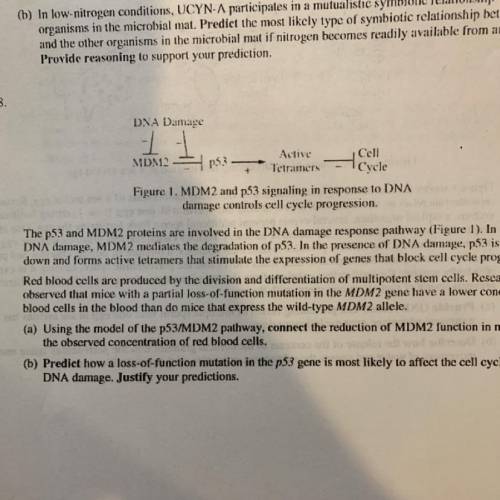
The p53 and MDM2 proteins are involved in the DNA damage response pathway (figure 1). In the absence of
DNA damage, MDM2 mediates the degradation of p53. In the presence of DNA damage, p53 is not broken
down and forms active tetramers that stimulate the expression of genes that block cell cycle progression.
Red blood cells are produced by the division and differentiation of multipotent stem cells. Researchers have
observed that mice with a partial loss-of-function mutation in the MDM2 gene have a lower concentration of red
blood cells in the blood than do mice that express the wild-type MDM2 allele.
(a) Using the model of the p53/MDM2 pathway, connect the reduction of MDM2 function in mutant mice to
the observed concentration of red blood cells.
(b) Predict how a loss-of-function mutation in the p53 gene is most likely to affect the cell cycle in response to
DNA damage. Justify your predictions.


Answers: 1


Another question on Biology

Biology, 21.06.2019 16:50
Which of the following would be least likely to support the modern concept of biological evolution? ( 2 points) a)different species of organisms with similar bone patterns b)different species of organisms with similar reproductive rates species in c)different domains with similar metabolic pathways species in d)different kingdoms with similar cellular structures.
Answers: 2

Biology, 22.06.2019 05:00
What best describes the dropping height of a ball that bounces back up to a height of 45 cm
Answers: 1

Biology, 22.06.2019 09:30
What's wrong with this ecological pyramid? (multiple choice)1. secondary consumers should be at the bottom of the pyramid2. the sun has an arrow leading to decomposers 3. primary consumers should come after the sun4. energy retained should increase from the bottom to the top5. the sun should be at the bottom of the pyramid
Answers: 1

Biology, 22.06.2019 15:00
How do temperature and salinity affect deepwater currents? they create changes in wind direction, moving denser water in the same direction as the wind and causing the deepwater circulation patterns found in the ocean. as temperatures and salinity levels of water increase, the water rises to the surface where it creates currents as it moves to colder regions. they create density differences that cause dense deepwater currents to flow toward the equator where they displace less dense, warmer water above them. they equalize the forces on undersea currents caused by the coriolis effect as they replace more dense water with less dense water.
Answers: 1
You know the right answer?
The p53 and MDM2 proteins are involved in the DNA damage response pathway (figure 1). In the absence...
Questions


Social Studies, 21.09.2021 19:10


English, 21.09.2021 19:10

Mathematics, 21.09.2021 19:10


Physics, 21.09.2021 19:10

Mathematics, 21.09.2021 19:10




Mathematics, 21.09.2021 19:10



Physics, 21.09.2021 19:10

Chemistry, 21.09.2021 19:10

History, 21.09.2021 19:10


Engineering, 21.09.2021 19:10



